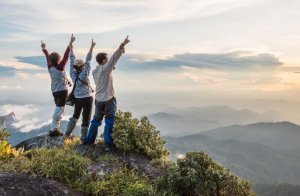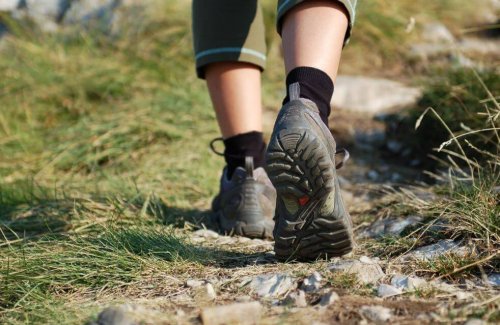Tips that you shouldn't forget when hiking

To enjoy hiking in the best possible way, it’s important to be guided by some tips that balance the lack of experience. It’s about enjoying the hike without any problems that may bother us excessively.
Plan your route
It’s one of the most important points since it will help you to decide which route is the best one for you and to know what difficulties to expect.
That’s why the best thing you can do is study the route in advance, from a map or plan, know the elevation gain, longitude, and route duration.
Another important factor to plan for is the date and time of day when you’re going to hike the route. You have to take into account the weather conditions and avoid hot summer hours and nightfall.

If the trail has a river that you have to cross, you must consider the season, so that the water level isn’t too high.
It’s always good to hike in a group because in the face of any mishap, no matter how small, it’s better to have help available. A good number of people to hike with is three. This way, if someone suffers an accident, one can stay with the injured person while the third one goes to find help.
If you’re not able to hike in a group, always inform someone you trust that you are going on a hiking trail. That way, if something happens to you and you can’t reach help, that person can inform the authorities to facilitate your location.
Prepare your backpack well for the hike
Think clearly about what you need to carry in your backpack, this will depend on the duration of the hike. For routes that last a few hours, some useful equipment can be:
–Water: this depends on the amount of heat and the effort involved in the route, but the average amount of a liter and a half (per adult) is appropriate.

–Food: it isn’t necessary to take too much food because apart from not wanting to carry a lot of weight, it isn’t advisable to binge during a hike. A good option is to take energy bars.
–A phone: in cases of emergency, it’s useful for notifying someone and to be easily located. Try to ensure that the battery is fully charged before going on a hike. If the trail is relatively long, it is better to turn the phone off to save battery life.
–Whistle: should a problem arise, a whistle makes it easier for someone to locate you and you’ll spend less energy than shouting.
–Small multipurpose knife: in Spain, for example, the knife you carry needs to meet with legal requirements. It must have a single edge, a blade less than 4.3 inches long, and it can’t be automatic.
–Flashlight: very useful for when it gets dark or due to any unforeseen occurrence. The most recommendable kind of flashlight for hiking is the headlamp, this way you have your hands free.
–Sunscreen: especially in the summer, but also for any time of the year and if the route is at a certain height above sea level.
Keep in mind that in order to be comfortable, the maximum recommended weight to carry is between 9 and 13lb. Anything above that weight can cause problems as you hike further.
Take a basic first aid kit
It’s very important for the first aid kit to be easily identifiable because if we have an accident, others have to find it fast. We can use a plastic bag to put the kit’s basic things inside it to prevent them from becoming wet in certain situations.
Appropriate clothing and footwear
To practice hiking, your footwear’s features must be:
- Side, toe, and heel protection
- External material resistant to abrasion
- Sole with a heel, with sufficient thickness and semi-rigid

Regarding clothing for the torso you should follow the three layer rule:
In winter, it’s advisable to use a thermal shirt as a first layer—one with synthetic fabric that facilitates perspiration and dries quickly. In summer, a loose shirt is suitable, also made of synthetic fabric.
The second layer is the coat. Usually a synthetic fabric—fleece for winter. A second layer with a zipper is usually more fitting since it allows us to regulate the ventilation of the body depending on physical activity and weather conditions.
In summer, it can be a light fleece if you plan to visit shady areas or regions of a certain height that are more exposed to wind.
The third layer will normally be a waterproof jacket during winter. In summer, the third layer will be a windbreaker or windcheater that can be carried in the backpack in case you catch an unexpected storm.
In conclusion, your legs aren’t the only important aspect of hiking. Other factors such as planning, the backpack, or clothing can ensure you have a much better journey.
To enjoy hiking in the best possible way, it’s important to be guided by some tips that balance the lack of experience. It’s about enjoying the hike without any problems that may bother us excessively.
Plan your route
It’s one of the most important points since it will help you to decide which route is the best one for you and to know what difficulties to expect.
That’s why the best thing you can do is study the route in advance, from a map or plan, know the elevation gain, longitude, and route duration.
Another important factor to plan for is the date and time of day when you’re going to hike the route. You have to take into account the weather conditions and avoid hot summer hours and nightfall.

If the trail has a river that you have to cross, you must consider the season, so that the water level isn’t too high.
It’s always good to hike in a group because in the face of any mishap, no matter how small, it’s better to have help available. A good number of people to hike with is three. This way, if someone suffers an accident, one can stay with the injured person while the third one goes to find help.
If you’re not able to hike in a group, always inform someone you trust that you are going on a hiking trail. That way, if something happens to you and you can’t reach help, that person can inform the authorities to facilitate your location.
Prepare your backpack well for the hike
Think clearly about what you need to carry in your backpack, this will depend on the duration of the hike. For routes that last a few hours, some useful equipment can be:
–Water: this depends on the amount of heat and the effort involved in the route, but the average amount of a liter and a half (per adult) is appropriate.

–Food: it isn’t necessary to take too much food because apart from not wanting to carry a lot of weight, it isn’t advisable to binge during a hike. A good option is to take energy bars.
–A phone: in cases of emergency, it’s useful for notifying someone and to be easily located. Try to ensure that the battery is fully charged before going on a hike. If the trail is relatively long, it is better to turn the phone off to save battery life.
–Whistle: should a problem arise, a whistle makes it easier for someone to locate you and you’ll spend less energy than shouting.
–Small multipurpose knife: in Spain, for example, the knife you carry needs to meet with legal requirements. It must have a single edge, a blade less than 4.3 inches long, and it can’t be automatic.
–Flashlight: very useful for when it gets dark or due to any unforeseen occurrence. The most recommendable kind of flashlight for hiking is the headlamp, this way you have your hands free.
–Sunscreen: especially in the summer, but also for any time of the year and if the route is at a certain height above sea level.
Keep in mind that in order to be comfortable, the maximum recommended weight to carry is between 9 and 13lb. Anything above that weight can cause problems as you hike further.
Take a basic first aid kit
It’s very important for the first aid kit to be easily identifiable because if we have an accident, others have to find it fast. We can use a plastic bag to put the kit’s basic things inside it to prevent them from becoming wet in certain situations.
Appropriate clothing and footwear
To practice hiking, your footwear’s features must be:
- Side, toe, and heel protection
- External material resistant to abrasion
- Sole with a heel, with sufficient thickness and semi-rigid

Regarding clothing for the torso you should follow the three layer rule:
In winter, it’s advisable to use a thermal shirt as a first layer—one with synthetic fabric that facilitates perspiration and dries quickly. In summer, a loose shirt is suitable, also made of synthetic fabric.
The second layer is the coat. Usually a synthetic fabric—fleece for winter. A second layer with a zipper is usually more fitting since it allows us to regulate the ventilation of the body depending on physical activity and weather conditions.
In summer, it can be a light fleece if you plan to visit shady areas or regions of a certain height that are more exposed to wind.
The third layer will normally be a waterproof jacket during winter. In summer, the third layer will be a windbreaker or windcheater that can be carried in the backpack in case you catch an unexpected storm.
In conclusion, your legs aren’t the only important aspect of hiking. Other factors such as planning, the backpack, or clothing can ensure you have a much better journey.
This text is provided for informational purposes only and does not replace consultation with a professional. If in doubt, consult your specialist.








